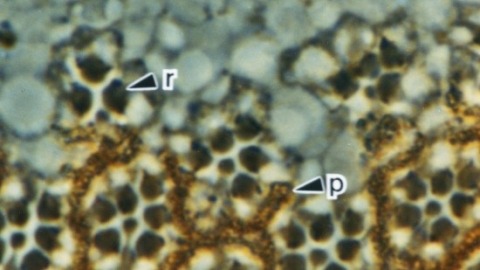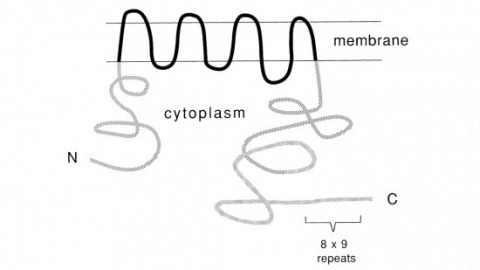Filter
Publication Date
Type of Publication
6 Publications
Showing 1-6 of 6 resultsTranscriptional promoters of mitochondrial DNA have diverged extensively in the course of mammalian evolution. Nevertheless, the transcriptional machinery and the overall mechanisms of transcriptional control and regulation seem to be conserved. We have compared the human and murine homologs of the major DNA-binding transcriptional activator, mitochondrial transcription factor 1 (mtTF1), with unexpected results. Both proteins have similar chromatographic and transcriptional properties and are the same size. Both recognize and bind sequences between -12 and -39 within their respective homologous promoters. However, the sequences that they recognize are markedly divergent; although the base pairs they contact are situated similarly or identically with respect to the transcriptional start site, sequence identity between the two species’ contact points is less than 50%. Interestingly, the two proteins are functionally interchangeable; each can bind to the heterologous light-strand promoter and can activate transcription by the heterologous mitochondrial RNA polymerase. Thus, the RNA polymerase or some as yet undetected transcription factor, rather than mTF1, may determine the strict species specificity of mitochondrial transcription. Flexible DNA sequence recognition by mtTF1, on the other hand, may be a principal facilitating mechanism for rapid control sequence evolution.
Null mutations of glass specifically remove photoreceptor cells, leaving other cell types intact. We have isolated the glass gene and have shown that its transcript encodes a putative protein of 604 amino acids with five zinc-fingers. The glass product may be a transcription factor required for the development of a single neuronal cell type.
Recent studies suggest that the fly uses the inositol lipid signaling system for visual excitation and that the Drosophila transient receptor potential (trp) mutation disrupts this process subsequent to the production of IP3. In this paper, we show that trp encodes a novel 1275 amino acid protein with eight putative transmembrane segments. Immunolocalization indicates that the trp protein is expressed predominantly in the rhabdomeric membranes of the photoreceptor cells.
The doublesex (dsx) gene regulates somatic sexual differentiation in both sexes in D. melanogaster. Two functional products are encoded by dsx: one product is expressed in females and represses male differentiation, and the other is expressed in males and represses female differentiation. We have determined that the dsx gene is transcribed to produce a common primary transcript that is alternatively spliced and polyadenylated to yield male- and female-specific mRNAs. These sex-specific mRNAs share a common 5' end and three common exons, but possess alternative sex-specific 3' exons, thus encoding polypeptides with a common amino-terminal sequence but sex-specific carboxyl termini. Genetic and molecular data suggest that sequences including and adjacent to the female-specific splice acceptor site play an important role in the regulation of dsx expression by the transformer and transformer-2 loci.
The D. melanogaster transformer-2 (tra-2) gene regulates somatic sexual differentiation in females and is necessary for spermatogenesis in males. Wild-type tra-2 function is required for the female-specific splicing of the pre-mRNA of the next known gene (doublesex) downstream of tra-2 in the sex determination regulatory hierarchy. The tra-2 gene was cloned, and P element-mediated transformation was used to demonstrate that a 3.9 kb genomic fragment contains all sequences necessary for tra-2 function. A 1.7 kb transcript was shown to be the product of the tra-2 locus based on its reduced level in flies containing a tra-2 mutant allele. The sequence of a cDNA corresponding to this transcript indicates that it encodes a polypeptide with strong similarity to a family of RNA binding proteins that includes proteins found associated with hnRNPs and snRNPs, suggesting that the tra-2 product may directly regulate the processing of the double-sex pre-mRNA in females.
Using complementary oligonucleotide probes, we have isolated the nuclear gene for the RNA moiety of RNAase MRP; it is present as a single copy and encodes an uncapped primary transcript of 275 nucleotides. Direct sequence analysis revealed that the 136 nucleotide RNA that copurifies with RNAase MRP represents the 3’ half of the 275 nucleotide primary transcript. The 5’-flanking region of the gene has putative transcriptional control elements homologous to the promoters of RNA polymerase II-transcribed U-series snRNA genes; however, the coding region possesses a box A sequence and terminates at four T residues, both features characteristic of polymerase III-transcribed genes. A decamer sequence, 5’-CGA-CCCCUCC-3’, complementary to a conserved sequence adjacent to the enzymatic cleavage site on the mitochondrial RNA substrate, is present in the RNAase MRP RNA. Isolation of a nuclear gene for the RNA component of a mitochondrial enzyme implies that nucleic acids can be transported across mitochondrial membranes.


